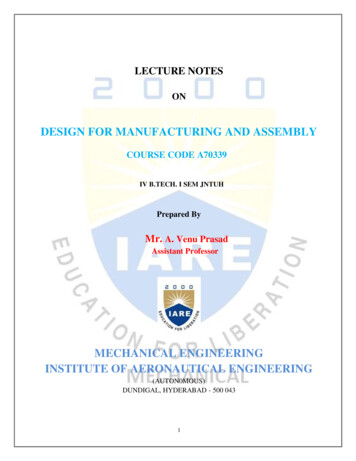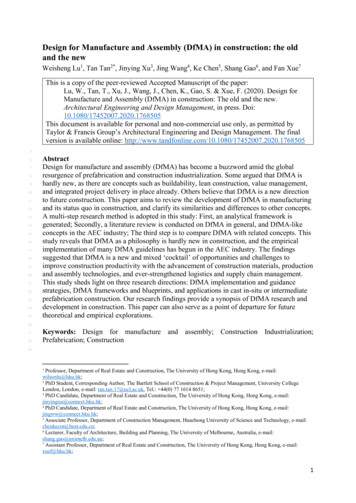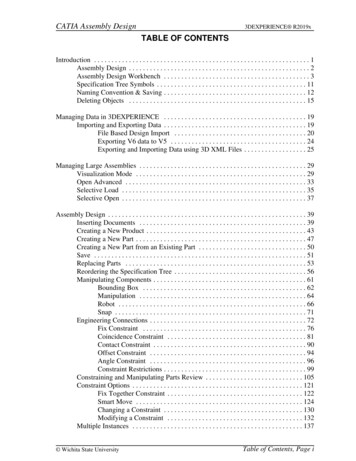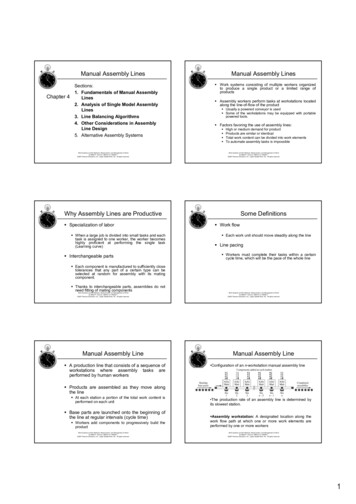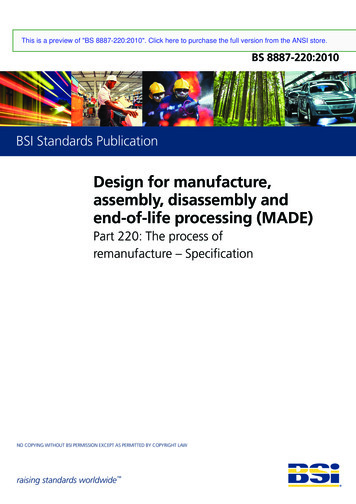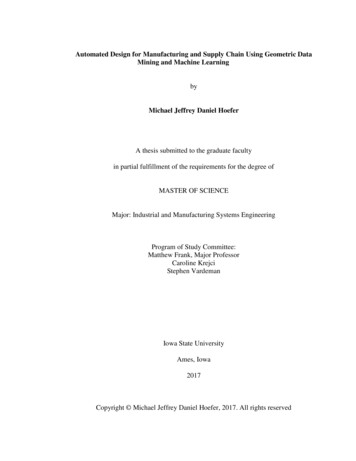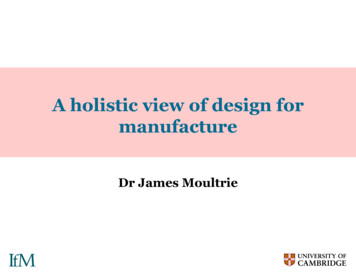
Transcription
See discussions, stats, and author profiles for this publication at: Design for manufacture and assembly in construction: a reviewArticle in Building Research and Information · December 2019DOI: 10.1080/09613218.2019.1660608CITATIONSREADS22833 authors:Gao ShangRuoyu JinUniversity of MelbourneLondon South Bank University39 PUBLICATIONS 392 CITATIONS85 PUBLICATIONS 642 CITATIONSSEE PROFILEWeisheng LuThe University of Hong Kong197 PUBLICATIONS 3,587 CITATIONSSEE PROFILESome of the authors of this publication are also working on these related projects:Changing cities View projectContent analysis of construction documents using semantic similarity models View projectAll content following this page was uploaded by Ruoyu Jin on 07 September 2019.The user has requested enhancement of the downloaded file.SEE PROFILE
Building Research & InformationISSN: 0961-3218 (Print) 1466-4321 (Online) Journal homepage: https://www.tandfonline.com/loi/rbri20Design for manufacture and assembly inconstruction: a reviewShang Gao, Ruoyu Jin & Weisheng LuTo cite this article: Shang Gao, Ruoyu Jin & Weisheng Lu (2019): Design for manufactureand assembly in construction: a review, Building Research & Information, DOI:10.1080/09613218.2019.1660608To link to this article: shed online: 05 Sep 2019.Submit your article to this journalView related articlesView Crossmark dataFull Terms & Conditions of access and use can be found ation?journalCode rbri20
BUILDING RESEARCH & 19.1660608Design for manufacture and assembly in construction: a reviewShang Gaoa, Ruoyu Jinband Weisheng LucaFaculty of Architecture, Building and Planning, The University of Melbourne, Melbourne, Australia; bDivision of Built Environment and CivilEngineering, School of Environment and Technology, University of Brighton, Brighton, UK; cDepartment of Real Estate and Construction, HongKong University, Hongkong, People’s Republic of ChinaABSTRACTARTICLE HISTORYDesign for Manufacture and Assembly (DfMA) is known as both a philosophy and a methodologywhereby products are designed in a way that is as amenable as possible for downstreammanufacturing and assembly. As construction is moving towards a combination of offsiteprefabrication and onsite assembly, DfMA is gaining momentum in this heterogeneous industry.Nevertheless, a comprehensive review of DfMA in construction, its prospects and challenges inparticular, seems absent from the literature. This study reviews the processes and principles ofDfMA and explores the possible perspectives of DfMA with a view to providing implications to theconstruction industry. It was found that DfMA in construction has been interpreted from threeperspectives: (1) a holistic design process that encompasses how structure or object will bemanufactured, assembled and guided with DfMA principles; (2) an evaluation system that can workwith virtual design and construction (VDC) to evaluate the efficiency of manufacturing andassembly; and (3) a game-changing philosophy that embraces the ever-changing prefabricationand modular construction technologies. This study suggests that development of design guidelines,forming multidisciplinary team, use of VDC systems and understanding the lean principles arefactors that could further enhance the successful application of DfMA in construction.Received 1 May 2019Accepted 22 August 2019IntroductionMany studies have explored various aspects of prefabrication, or otherwise known as offsite manufacturing,including its business models (Goulding, Rahimian,Arif, & Sharp, 2015; Pan & Goodier, 2011), barriersand constraints (Blismas, Pendlebury, Gibb, & Pasquire,2005; Mao, Shen, Pan, & Ye, 2013), benefits (Blismas,Pasquire, & Gibb, 2006) and opportunities (Arif, Goulding, & Rahimian, 2012; Goodier & Gibb, 2007). However, a report from KPMG (2016) cautioned ‘offsitemanufacturing alone will not overcome the challengesthe construction industry is facing, to do so requires apartnership with an integrated design process, like theDesign for Manufacture and Assembly (DfMA)method’. DfMA method is commonly known as methodological procedures for evaluating and improvingproduct design for both economic manufacturing andassembly. Unlike the increasing uptake of lean thinking(originated in manufacturing) by construction firms toimprove the construction process, very few studies(Fox, Marsh, & Cockerham, 2001) attempted to shedlight on best practices of design engineers, the buildingdesigner’s counterparts in manufacturing, in the designCONTACT Shang Gaoshang.gao@unimelb.edu.au 2019 Informa UK Limited, trading as Taylor & Francis GroupKEYWORDSDesign for manufacture andassembly (DfMA);construction; design;prefabrication; assembly;lean constructionstage such as the DfMA method. As Dewhurst (2010)noted, ‘what we have forgotten along the way is thatthe design of the product itself ultimately controls thetotal cost’. DfMA can guide cost reduction effortsearly in the product design process, so that product’sfull potential of lean production can be realized sincesome potential manufacturing problems and assemblyissues have already been addressed in the design. Theaim of this paper is to review critically the conceptsand principles of DfMA, to discuss the perspectives ofDfMA in the construction industry, and to suggestkey strategies for better implementation of DfMA inconstruction.Review of DfMADfMA: conceptThere are two components of DfMA, design for manufacture (DfM) and design for assembly (DfA) (Bogue,2012; Otto & Wood, 2001). DfM is principally concernedwith making individual parts, DfA addresses the meansof assembling them (Bogue, 2012). The research onDfA is pioneered by Boothroyd and Dewhurst (1987)
2S. GAO ET AL.who conducted a series of studies considering the assembly constraints during the design stages. This helps avoidthe manufacturing and assembly issues in the downstream stages of the product development (Emmatty &Sarmah, 2012). Based on the premise that the lowestassembly cost can be achieved by designing a productthat can be economically assembled by the most appropriate assembly system. The key principle is to produce adesign with fewer parts as well as designing the partswhich remain easy to assemble (Stoll, 1986). The fewerthe number of parts, the greater is the probability thatall of them will be placed correctly (Bridgewater, 1993).To achieve that, Boothroyd and Dewhurst’s (1987) handbook introduced various ratings for each part in theassembly process based on the part’s ease of handlingand insertion. According to Emmatty and Sarmah(2012), the parts do not satisfy the following criteriashould be eliminated: (1) the part moves relative to allother parts already assembled during the normal operation of the product; (2) the part must be of a differentmaterial, or must be isolated from all other parts alreadyassembled; (3) the part must be separate from all otherparts already assembled. In the construction context,the implication of DfA concept is to consider howaspects of the design can be designed in a manner thatminimizes work on site, and in particular, avoids ‘construction’ (RIBA, 2013). An example would be designinga handrail system that allows half landing lengths to bequickly installed into sockets which are pre-positionedin the stair structure (RIBA, 2013).DfM, on the other hand, compares the use of selectedmaterials and manufacturing processes for the parts ofan assembly, determines the cost impact of thosematerials and processes, and finds the most efficientuse of the component design (Ashley, 1995). In Layman’sterm, DFM aims to design parts that are easier, cheaperand more efficient to manufacture (Emmatty & Sarmah,2012). O’Driscoll (2002) defined DfM as the practice ofdesigning products with manufacturing in mind, withits goal is to reduce costs required to manufacture a product. Interestingly, O’Driscoll (2002) argued that theprinciple of DfM is at least 200 years old, citing LeBlanc,a Frenchman, devised the concept of interchangeableparts in the manufacture of muskets which were previously individually handmade (Bralla, 1999). For construction, DfM is the process of designing in a mannerthat enables specialist subcontractors to manufacture significant elements of the design in a factory environment(RIBA, 2013). Panelized system such as claddings havebeen designed in this manner for years, and now theemerging hybrid systems (i.e. pods) and modular buildings (i.e. fully factory-built houses) also pertain to theDfM concept.From the above descriptions of DfM and DfA, it wasfelt that these two disciplines are appropriate to be considered together, as one term – DfMA (Bogue, 2012).This is because products now are complex and the abilityto assemble them effectively is equally critical. Constance(1992) noted that DfMA was a management and software tool enables designers to consider a product’smaterial selection, design, manufacturability, and assembly up front. Boothroyd (2005) outlined the originalDfMA analysis method which provided methodologicalprocedures for evaluating and improving product designfor both economic manufacturing and assembly. WhenDfMA was introduced to manufacturer such as Douglasaircraft in California, it was labelled as a design reviewmethod that identified the optimal part design, materialschoice, and assembly and fabrication operations to produce an efficient and cost-effective product (Ashley,1995). The goal is to provide manufacturing input atthe conceptualization stage of the design process in alogical and organized fashion.DfMA: process and principlesThe typical DfMA process can be arranged into stages, assummarized in Figure 1. Boothroyd (1994) has notedthat DfA should always be the first consideration, leadingto a simplification of the product structure. This is followed by the economic selection of materials and processes and early cost estimates. In this process, costestimates for original design and new (or improved)design will be compared, in order to make trade-offdecision. Once the materials and processes have beenfinally selected, a more thorough analysis for DfM canbe carried out for the detailed design of the parts. Atthis stage, DfM is assisted with guidelines for standardization, component design and component assembly toreduce total manufacturing cost.Fox et al. (2001) noted that design engineers are provided with standard design improvement rules or guidelines in workbooks and standard design evaluationmetrics in manuals for evaluating a design with respectto its ease of assembly. If a concept is compatible withthese guidelines, one can be reasonably assured thatthe design will be fairly well in the subsequent detailedanalysis (Otto & Wood, 2001). In this manner, a feedback loop is provided to aid designers measuringimprovements resulting from specific design changes(Boothroyd, 2005). Afterwards, the best design is takenforward to a more thorough analysis for DfM, wherethe detailed design for the parts will be performed (Boothroyd, 1994).According to Bogue (2012), there are three means ofapplying a DfMA process. The first is to follow a general
BUILDING RESEARCH & INFORMATION3Figure 1. Typical stages in a DfMA procedure. Source: Boothroyd (2005).set of non-specific and qualitative rules or guidelines andrequire someone (most likely designers and engineers) tointerpret and apply them in each individual case. Theaim is to encompass a diversity of products, processesand materials. Table 1 provides an example of suchDfMA guidelines and their associated benefits. Similarly,Stoll (1986) outlined ten DfMA principles and rules: (1)minimizing total number of parts, (2) developing a modular design, (3) using standard components, (4) designing parts to be multifunctional, (5) designing parts formulti-use, (6) designing parts for ease of fabrication,(7) avoiding separate fasteners, (8) minimizing assemblydirections, (9) maximizing compliance, and (10) minimizing handling.A close examination reveals that despite these guidelines/principles from various reference points, theyshare substantial similarities, such as minimization,standardization, and modular design to be the keycharacteristics of DfMA principles. This is in line withthe heuristic principles of Koskela’s (2000) flow conceptof production: (1) simplify by minimizing the numberof steps, parts and linkages, (2) increasing flexibility,and (3) increasing transparency. As Koskela (2000)noted: ‘simplification can be realized, on one hand, byeliminating non-value-adding activities from theproduction process, and on the other hand by reconfiguring value-adding parts or steps’. The implication ofthis heuristic principle, in the context of DfMA, is fordesigners to rethink their designs as to what extentthe criteria that they applied in their designs wouldaffect the production and assembly that may causeextra motions.The second method employs a quantitative evaluationof the design. The rationale is that each part of the designcan be rated with a numerical value depending on its‘assemblability’ (Bogue, 2012). Subsequently, the numbers can be summed for the entire design and the resulting value is used as the guide to evaluate the overalldesign quality. Another evaluation tool is based on a100-point method with demerit marks being given forfactors which hamper the ease of assembly.The third approach which is most recently developedis the automation of the entire process. It relies on computer software. Quantitative analysis can be applied tothe design, followed by constructing an expert systememploying the general design rules. The system can bedeveloped in a way that a design can be analysed, evaluated, and then optimized repeatedly by applying the rulesto improve the design quality after each iteration. In thisconnection, it is particularly important that the DfMA
4S. GAO ET AL.Table 1. General DfMA guidelines and their benefits.GuidelinesBenefits1. Minimize the part countImproved reliability, reducedpurchasing and inventory costs,simplified assembly1. Use standard, off-the-shelf partsrather than custom componentsReduced costs, lower purchasinglead times, potentially greaterreliability1. Minimize and standardize the useof fasteners/design for efficientjoining and fasteningReduced costs, simplified assembly,improved reliability, simplified repairand maintenance1. Use as few dissimilar materials aspossibleSimplified jointing, fewermanufacturing processes1. Minimize the use of fragile partsCost reductions due to fewer partfailures, easier handling andassembly1. Do not over-specify tolerances orsurface finishEasier manufacture and reducedfabrication costs1. Design for ease of fabricationCost reductions from the eliminationof complex fixtures and tooling1. Consider modular designsReduced costs due to simplifiedassembly and test1. Aim for mistake-proof designsCost reductions by eliminating needto re-work incorrectly assembledparts1. Design for simple part orientationand handlingCost reductions due to non-valueadded manual effort or dedicatedfixturing1. Design with predeterminedassembly technique in mindCost reductions from use of proven/known techniques1. Consider design for automated/robotic assemblyPotential cost reduction over manualmethodsSource: Bogue (2012).rule based evaluation tool is linked to a production database (Fox, Marsh, & Cockerham, 2002).DfMA in construction: a research gapConstruction on site is portrayed by Ballard and Howell(1998) as a combination of fabrication and assembly.Industrialization initiatives are believed to be the driverto shift as much work as possible from site constructioninto shop conditions where it can be done more efficiently (Ballard & Howell, 1998). The key to mass productionin construction is not the continuous assembly line.Rather, it was the complete and consistent interchangeability of parts and the simplicity of attaching them toeach other (Crowley, 1998). Since Koskela (1992)brought the production theory into construction, muchhas been written about the lean concept and lean toolsto make the site assembly efficient (Tommelein, 1998).The focus of lean is predominately focused on the construction process. However, discussions around howdesign or production development contributes to a bettermanufacturing and assembly were limited, even thoughBallard and Howell (1998) described construction is‘essentially a design process in which the facilitiesdesigned are rooted-in-place, and thus require siteassembly’. Given the limited source of DfMA in the construction literature, this paper attempted to explore whatare the emerging interpretations of DfMA in construction, what typical benefits that DfMA could bring tothe construction industry along with the challengesassociated with the DfMA adoption in construction.MethodA study examining the DfMA in construction is overdue.This study uses existing literature to examine the construction perspectives to DfMA concept. As pointedout by (Nakamba, Chan, & Sharmina, 2017), systematicreviews allow researchers to examine the strength of thepublished evidence as unbiased as possible. Following onthe steps of conducting a systematic literature reviewoutlined by (Tranfield, Denyer, & Smart, 2003), thefirst step in the systematic review was to identify theresearch. Scopus was searched for publications whosetopics include at least one of ‘design for manufactureand assemble’, ‘design for manufacture’, ‘design forassembly’, ‘DfMA’, ‘design for construction’, and ‘construction’. The search was limited to peer-reviewed published articles in English. A total of 232 hits resulted froman initial search for any one instance of the phrases.Next, inclusion and exclusion criteria were set. The former includes (1) Articles must be written in English andproduced by peer-reviewed journals; (2) articles that discuss DfMA in the construction industry. On the otherhand, the exclusion criteria apply to those studies (1)lack a focus in the construction industry; (2) only focuson DfMA generally; or (3) articles only mentionedDfMA only in passing. Knowing these criteria, the searchwas performed in March 2019; articles published by thenand appearing in the database were considered. Afterviewing the title, keywords, and abstracts of the 232articles, 23 of them were retained as matching thetopic. Another three papers with similar themes, butfor various reasons not returned by the search, wereadded manually, giving a pool of 26 journal articles. Itis worth mentioning that 9 out of 26 articles (34.6%)were published in the last two years (2018–2019), indicating that DfMA only recently become a populartopic. Our pool is close in size to 30 papers minimumthreshold for literature reviews suggested by Wee andBanister (2016). The 26 articles were thoroughlyreviewed which leads to the last steps involved analysisand synthesis of the selected literature to identify any
BUILDING RESEARCH & INFORMATIONemerging categories. The next section reports threeemerging perspectives of DfMA in construction, alongwith the typical benefits of implementing DfMA. Thediscussion section begins with the challenges associatedwith DfMA implementation, followed by proposingstrategies for dealing with challenges.FindingsDfMA: a systematic processFirst, DfMA is viewed as a systematic procedure, whichcan add value to the construction/production processby standardizing component and reducing design variabilities (Goulding et al., 2015). Several research presented their customized DfMA process in differentcontexts to different components. For example, Pasquireand Connolly (2003) documented a three-step DfMAprocess that Crown House Engineering1 adopted formechanical services installations.Step 1 – It begins with a generic intent to use manufactured components and an understanding of thebenefits and limitations of pre-assembly products.Step 2 – design process comprises four main activities:(1) understanding the interfaces between the structureand the services ensuring design integration, (2) feasibility study of the selection of products, componentsand pre-assembly unit system, (3) development of thedesign process programme and identification of coordination activities, and (4) preparation of manufacturingdrawings and involvement of supplier specifications,and the coordination of the manufacturing input.Step 3 – the manufacturing phase is the final stepwhich comprises of three activities: (1) factory assembly, (2) releasing the manufactured components by5signing-off the production checklists, and (3) on-siteinstallation.Apart from the documented DfMA process on building services design and assembly, Gerth, Boqvist, Bjelkemyr, and Lindberg (2013), based on the principles ofDfMA and lean, developed the ‘Design for Construction’(DfC) model which complements the conventional construction process with the following four steps (seeFigure 2): (1) specifying customer values and similar previous projects; (2) identifying onsite waste and cost drivers in previous projects; (3) developing criteria toevaluate constructability; and (4) evaluate constructability of the design. The presented steps of DfC method isonly taking place in the concept development and designstage, which is in line with the process of DfMA in themanufacturing literature. It is interesting to see thismethod encourages designers to capture the productionexperience from past projects and use it during design. Itis also worth mentioning that the DFC method has aniterative nature which enables building design to befurther improved until it reaches a satisfactory levelwith regard to the evaluation criteria (Gerth et al.,2013). The imperatives for this process are a teamapproach or simultaneous engineering, an attitude toresist making irreversible design decisions as long aspossible, and a commitment to the continuous optimization of product and process (Luiten & Fischer, 1998).Moreover, in the 3D modelling environment, Yuan,Sun, and Wang (2018) also presented a parametric precast component creation process based on DfMA whichis running in Revit (i.e. a Building Information Modelling tool). As Yuan et al. (2018) claimed, the first thingof this process is to conduct DfMA analysis so as totimely integrate the detailed information required bymanufacture and assembly stages of precast componentFigure 2. The four steps of DFC and their placement in the housing project process Source: Gerth et al. (2013).
6S. GAO ET AL.into the design stage, such as geometry, connection,manufacturing process, assembly process, and mechanical equipment. It is good to have structured steps orguidelines to perform DfMA process given this methodis just taking place in the construction industry. It isalso noted that a common theme that occurs in thesestructured processes is the timely feeding and analysisof the information required by manufacture and assembly stages into the design stage. In Luiten and Fischer’s(1998) words, DfMA changes the traditional sequentialprocess to a process where design and manufacturingare reciprocally dependent.DfMA: an evaluation modelSecondly, DfMA is the development of an evaluationmethod. Leaney (1996) concluded that the real achievement of DfMA methods is their ability to providemeasurements of assemblability which allows objectivecriteria to be applied in a team-based situation. Hence,calculating an assembly index for each part to see howproduction cost, time and quality are affected is desired.Leaney (1996) provided insights into three leadingDfMA evaluation methods, namely Hitachi method,Boothryd-Dwehurst method, and Lucas method. A comparison of the three methods is summarized in Table 2.Caution was also voiced out by Leaney (1996) thatthese methods focused on mechanical based assembliesof a size that could be conveniently assembled at adesk top. It may seem that these methods and proceduresare not applicable to products with the size of prefabricated components, or modular units. However, varioustypes of the indices, and evaluation procedures are stillworth exploring, which might add value to the body ofknowledge in the appraisal method of design performance on downstream construction. Apparently, the closest counterpart of ‘assemblability’ in construction, isbuildability which is regarded as both a ‘design method’and a ‘design objective’ (Fox et al., 2001). Fox et al.(2001) noted ‘process complexity is seen as a barrier todefining buildability, and production design proceduresassociated with buildability remain largely informaland reliant on intuitive application’. Singapore’s ‘Buildable Design Appraisal System’ (BDAS) perhaps is theonly tool available to quantify the effect of buildabilityon construction productivity (Jarkas, 2015). In theBDAS, key components such as structure, and wall components were enumerated with a corresponding laboursaving index. In another word, each value is given to adesign choice, and the total value determines the levelof buildability. The higher the buildable score wouldindicate a more efficient use of labour in construction.In the most recent code of practice of buildability(BCA, 2017a), bonus points are allocated for the use ofa number of DfMA technologies. The scoring systemallows product designer and building designer, in thecase of buildability, to take advantage of the opportunityto redesign based on the numerical values. This requiresinsight and knowledge of the building designers. However, Poh and Chen (1998) clarified that the corresponding labour-saving value for the BDAS is derived fromundocumented site productivity studies on variousdesign systems, and represents the aggregated wisdomof a panel of experts. Besides the quantification of buildability in construction, Gerth et al.’s (2013) DfC aims toimprove constructability and to minimize the number ofcomponents, parts and materials that need to be processed, assembled, and handled onsite. To achieve that,a performance index was created to evaluate to whatextent the design could achieve the predefined criteria,which is given a factor of relevance (R), and a grade(G). By multiplying the factor of relevance (R) and thegrade (G), the total points (P) is obtained for each criterion. The evaluation is done from a waste creatingapproach on the premise that each case-specific evaluation criterion can create many types of waste and isTable 2. Comparison of three different DfMA evaluation methods.EvaluationmethodsAimIndicesKey featuresHitachi methodTo assess design quality or the difficulty of assemblyoperations, and to estimate assembly costimprovementAssemblability evaluation score, EEstimated assembly costratio, K.Defining the motions and operationsFilling of a form in the order as the anticipatedassembly sequenceLucas DFATo assigning and sum penalty factors associated withpotential design problemsThree assemblability indicesDesign efficiencyFeeding rationFitting ratioThe penalty factors and indices give a relativemeasure of assemblability difficulty.This method is not based on monetary costsBoothrydDwehurstTo establish the cost of handling and insertingcomponent parts whether this is done manually orby machinesDFA indexTotal number of partsThe ease of handling, insertion,and fastening of the partsA paper based evaluationAnswering questions about potential handlingdifficulties, size, weight and amount oforientingAnswering questions about insertionrestrictionsSource: Adapted from Leaney (1996).
BUILDING RESEARCH & INFORMATIONattached with negative effects (Gerth et al., 2013). A casestudy of a wall solution can be found in Gerth et al.(2013). Moreover, Gbadamosi et al. (2019) identified alist of assessment criteria – based on the DfMA conceptand lean construction principles – for the design optimization of assembly. Factors were identified and prioritized to obtain their weighted importance to the overallassessment system. However, Gbadamosi et al. (2019)study is mainly focusing on the assembly knowledge factors. The identified 14 attributes fall under (1) ease ofassembling, (2) ease of handling, (3) speed of assembling,and (4) assembly waste. Yuan et al.’s (2018) work mentioned manufacturing simulation, transportation simulation, and assembly simulation are added into theDfMA-oriented design process. However, the evaluationcriteria of the aforementioned simulations are not provided. Yuan et al. (2018) only advised that these simulations should be carried as many as possible to surfacepotential problems caused by the design. It is reasonableto believe that the sophisticated evaluation criteriashould have been programmed into these various setsof simulation software.DfMA: prefabrication technologiesLastly, DfMA was closely associated with prefabrication(Laing O’Rourke, 2013), to which a bundle of gamechanging technologies that can be applied (BCA, 2016).The study of Trinder (2018) involved interviewing seniorengineers and managers in the UK water industry, andfound three clear themes to identify what they believeDfMA meant for construction, namely (1) off-site, (2)modular, and (3) standardized. The Royal Institute ofBritish Architects (RIBA, 2013) defines DfMA as anapproach that facilitates greater offsite manufacturing,thereby minimizing onsite construction. More specifically, the RIBA (2013) noted that DfMA harnesses awide spectrum of tools and technologies, including (1)volumetric approaches, (2) ‘flat pack’ solution,2 and (3)prefabricated sub-assemblies. Clearly, these themes or7technologies are fundamental to modern manufacturingwhere products are commonly standardized and massproduced off-site (Trinder, 2018). Similarly, in Singapore, the concept was interpreted in a similar fashion.It was first recommended as a key recommendationduring the International Panel of Experts (IPE) for Construction Productivity and Prefabrication Technology in2014, where the panel called for fundamental changesand stronger measures in the 2nd construction productiv
Design for Manufacture and Assembly (DfMA) method’. DfMA method is commonly known as meth-odological procedures for evaluating and improving product design for both economic manufacturing and assembly. Unlike the increasing uptake of lean thinking (originated in manufacturing) by constr

